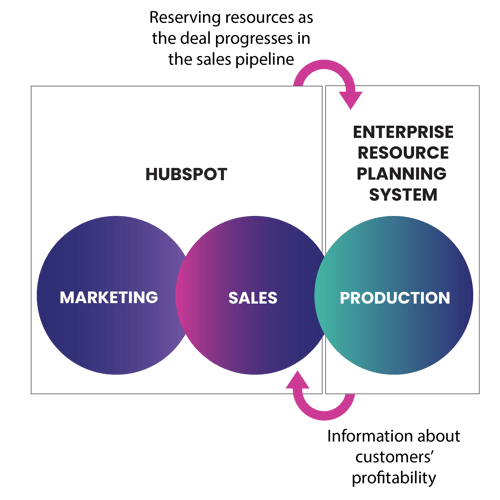Integrating an ERP system with HubSpot
The balance between production resources (people) and sales is familiar to many service organizations. Unlike in the SaaS business, for example, resources do not scale at the touch of a button: balancing production capacity with sales is a real challenge. Growth requires sales, and while accelerating sales is a so-called “positive problem,” fulfilling sales promises and delivering the promised service on schedule is a key part of doing business. On the other hand, selling too cautiously affects business growth negatively and free resources eat up the company’s margins.
HubSpot focuses on streamlining the work of marketing, sales and customer service and cannot alone replace the key part of project management and service business that is run through ERP systems. Resourcing projects and customerships, implementing time recording and introducing HR functionalities are not at the core of HubSpot. Even we as a HubSpot experts want to be completely honest about this. As we know, the most complete picture of the customer base is created when all the data is stored in one place. It is therefore ideal to bring marketing, sales and production data into one integrated process. The integrations of the sales CRM system and the ERP system enhance the communication between the teams, the timeliness and predictability of resources, and bring important information for both sales and marketing about the profitability of different types of customers.

An example of an integration: connecting HubSpot to Severa
Visma Severa is a project management system where projects, customer relationships and internal resources are managed from sales to invoicing. The HubSpot-Severa integration links marketing, sales and production processes: while teams work on separate systems, they are all up-to-date on the overall picture. Through integration, sales advance deals with the sales deal pipeline and trigger resource allocations from production well in advance of the actual closing of the deal. The production team monitors any possible resource needs in the near future and is thus able to anticipate its own operations in accordance with the sales pipeline.
When a deal’s status is set as confirmed in HubSpot's CRM deal pipeline, it is also automatically transferred as a project to Severa's environment. Experts and project teams record their hours in Severa, where they are attached to specific customer relationships and projects. At the end of the project, information about the accrued costs and the work billed to the customer is transferred back to HubSpot, where sales can view the profitability of the entire project from one place.
Together, the two systems form a comprehensive package that handles sales and marketing planning and reporting, lead and entire sales pipeline management, project management and related billing and cost tracking. Both HubSpot and Severa have their own, advanced strengths: Severa focuses on project management and HubSpot on sales and marketing automation.
What to consider when integrating an ERP system and HubSpot
Typical issues that are taken into account in the integration planning phase are, for example, where the master data (customer register) is maintained and what historical data is transferred between the systems. In an integration project, company-specific special needs and operational processes are identified and taken into account, so that the implementation provides the greatest possible benefit in terms of the company's (and teams') goals and reporting needs.
So select a partner with specialized expertise in both business process design in the HubSpot environment and strong technical expertise in integrating the HubSpot interface with ERP systems. Ready-made plug-and-play integrations offer entry-level solutions, but if you are looking for a solution that best serves your organization's needs, it's time to turn to a technical HubSpot integration partner.
Better visibility into the overall picture of the entire customership
Automation handles data transfer and enables up-to-date reporting. With integration errors, that easily result from manual data transfer and multiple entries, are avoided. Reporting becomes more simple and automated: no time spent on searching for data, combining and rotating it. Instead the status of the sales pipeline is clear to both the sales and production teams. Monitoring the profitability of sales and marketing activities becomes clearer and easier. The integration streamlines the processing of all customer data between the two systems, as well as enables step-by-step monitoring of the productivity during the entire customer path.
Integration also accelerates the transition of knowledge from marketing to sales and vice versa: both teams can easily see how their actions affect customer productivity. Customer relationship management becomes a sleek process from the initial step of lead identification to invoicing.
Are you considering integrating your ERP system with HubSpot?
We at Kaksio Labs specialize in technical HubSpot solutions such as integrations, migrations and the development of custom HubSpot applications. You can visit our HubSpot - Severa integration here or open a discussion with us about other ERP system integrations - we are happy to help!
/kaksio-labs-logo-white.png?width=150&height=69&name=kaksio-labs-logo-white.png)
